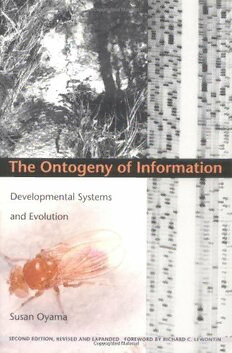Table Of ContentThe Ontogeny
of Information
Susan Oyama
ScienceandCulturalTheory
ASeriesEditedbyBarbaraHerrnsteinSmith
andRoyE.Weintraub
The Ontogeny
of Information
Developmental Systems and Evolution
SecondEdition,RevisedandExpanded
Susan Oyama
ForewordbyRichardC.Lewontin
Secondedition,revisedandexpanded
©byDukeUniversityPress
OriginallypublishedinbyCambridgeUniversityPress
Allrightsreserved
PrintedintheUnitedStatesofAmericaonacid-freepaper(cid:7)
DesignedbyC.H.Westmoreland
TypesetinTimesRomanwithDinNeuzeitdisplay
byTsengInformationSystems,Inc.
LibraryofCongressCataloging-in-PublicationData
appearonthelastprintedpageofthisbook.
Contents
ForewordbyRichardLewontin vii
PrefacetoSecondEdition xvii
Preface xix
1 Introduction
2 TheOriginandTransmissionofForm:
TheGeneastheVehicleofConstancy
3 TheProblemofChange
4 VariabilityandOntogeneticDifferentiation
5 VariationsonaTheme:
CognitiveMetaphorsandtheHomunculoidGene
6 TheGhostsintheGhost-in-the-MachineMachine
7 TheOntogenyofInformation
8 Reprise
9 Prospects
AfterwordtoSecondEdition
Notes
References
IndexofNames
IndexofSubjects
This page intentionally left blank
Foreword
The first edition of The Ontogeny of Information () was instigated
byagrowingimpoverishmentofexplanationandunderstandingofhow
organismscometobe.Asaconsequenceofalonghistoryofdiscovery
in genetics and especially in molecular genetics, together with a virtu-
allycompletestagnationoftheclassicalscienceofexperimentalembry-
ology,explanationsofhoworganismsgrowanddifferentiatetoproduce
theircharacteristicformsandpropertieshadbecomeframedentirelyin
terms of the ‘‘turning on’’ and ‘‘turning off’’ of genes. Already in ,
at the Cambridge University symposium commemorating the one hun-
dredthanniversaryofDarwin’sdeath,SydneyBrennerinhiskeynotead-
dresshaddeclaredthatgiventhecompletesequenceofanorganism
and a large enough computer it would soon be possible to compute the
organism.By,thegeneticboaconstrictorhadtotallyenfoldedem-
bryologyinitshelicalcoils.Now,nearlyfifteenyearslater,thehelpless
victimhasdisappeareddownthemolecularmawandisslowlybeingdi-
gested.Intheend,ofcourse,theresultwillbewhatistobeexpectedfrom
suchaprocess:aslightenlargementofthebodyoftheconsumerandthe
productionofalargeamountoffecalmatter.
AsSusanOyamaexplainsinTheOntogenyofInformation,therearetwo
difficultieswiththecurrenttrendofexplanationofdevelopment.Thefirst
isthatthewrongquestionisbeingasked;thesecondisthat,eventothe
extentthatweareconcernedwiththeanswertothatquestion,thewrong
answerisbeinggiven.Whenthewrongquestionisbeingasked,itusually
turns out to be because the right question is too difficult. Scientists ask
questionstheycananswer.Thatis,itisoftenthecasethattheoperations
ofasciencearenotaconsequenceoftheproblematicofthatscience,but
thattheproblematicisinducedbytheavailablemeans.ThegeneticistAl
Hersheyusedtosaythatheavenisfindinganexperimentthatworks,and
thendoingitoverandoverandover.Sequencingiseasy;anydamn
viii Foreword
foolwithamachinecandoit.Itisrathermoredifficulttomakegenetic
constructsofjusttherightsorttoalterorknockoutthereadingofparticu-
lar genes, but a competent Drosophila geneticist can usually manage it.
Ontheotherhand,nooneseemstoknowevenhowtoaskanexperimen-
talquestionabouttheactualcomingtogetherofmoleculestomakecell
organelles,orwhymyrearappendageslooklikelegsandfeetwhilemy
frontappendagesarearmsandhands,orwhyaparticularmicroanatomy
ofthecentralnervoussystemallowsthereadertounderstandthispage.
Thereasonthatthewronganswerisbeinggiven,eventothequestions
weknowhowtoask,isthatsomeformsofthinkingwedependonlead
usastray.First,wedonotknowhowtodispensewithmetaphoricallan-
guageandareoftenvictimizedbypropertiesofthemetaphor.Physicists
canspeakofthe‘‘billiardball’’modelofcollidingmoleculeswithoutsup-
posingthatmoleculesaremadeofplastic,orthattheyareredandwhite,
or that they make a clicking sound when they hit each other. But when
biologistsspeakofgenesas‘‘computerprograms,’’theyerroneouslysup-
pose that all the organism’s attributes are prefigured in its genes and all
thatisrequiredforafixedoutputisfortheenterkeytobepressed.
Second,unlikephysicists,whohavelearnedtoberathermoresophis-
ticated, biologists, who imagine that theyare following the example of
physics, have a simplistic notion of causes and effects. If A and B are
causallyconnected,theythink,theneitherAisthecauseandBtheeffect
or viceversa. But no physicist would try to identify the separate cause
andeffectinthecoupledelectromagneticequations.Themagneticfield
does not cause the electric field any more than the electric field causes
themagnetic.Thereissimplyapairofcoupleddifferentialequationsde-
scribingtheelectromagneticphenomenathataretwoaspectsofthesame
process.Norisitthecase,asbiologistsusuallybelieve,thatequalcausal
forces have equal effects. In a dynamical process in time it is also nec-
essary to take account of initial conditions. If I drive eighty miles west
andtwenty-fivemilesnorth,itisimpossibleforyoutoknowthatIwill
arriveinBrattleboro,Vermont,unlessyouknowthatIstartedinBoston.
Norcanphysicalprocessesbecountedontobehaveinadeterminateway
whentheyarebasedonaverysmallnumberofreactivemoleculesirregu-
larlydistributedinspace,asisthecaseformostoftheimportantreactants
withincells.
Throughoutthehistoryofmodernbiologytherehasbeenaconfusion
Foreword ix
betweentwobasicquestionsaboutorganisms:theproblemoftheoriginof
differencesandtheproblemoftheoriginofstate.Atfirstsighttheseseem
tobethesamequestion,andtakenintherightdirection,theyare.Afterall,
ifwecouldexplainwhyeachparticularorganismhasitsparticularform,
thenwewouldhaveexplained,paripassu,thedifferencesbetweenthem.
But the reverse is not true. A sufficient explanation of why two things
are different may leave out virtuallyeverything needed to explain their
nature.SupposethatontherailwaylinebetweenBostonandNewYork
there is a switch that, when set to the right, sends the train on a direct
southwesterlyroutebetweenthecities,but,whensettotheleft,shuntsthe
trainonacircuitouspathwestwardandthensouthwardalongtheHudson
River.Inresponsetothequestion,‘‘Whydidittakeyoueighthourstoget
toNewYorkfromBostoninsteadoftheusualfive?’’Imightquiteprop-
erlyanswerthattheswitchwassettotheleft,butthattellsnothingabout
theimmensecomplexityofmechanicalandsocialforcesinvolvedinthe
phenomenon of train travel. Indeed, the scheme of explanation of form
offeredbymoderndevelopmentalgeneticsisthatofasignalingnetwork
amonggenesthatresemblesnothingsomuchastheilluminatedmapon
thewallofarailroadcontrolroomwithredandgreenlightstwinklingon
andoffastheswitchesarereset.Thetemptationtosubstitutetheexpla-
nationofdifferencesforanexplanationofoutcomes,substitutingamap
of the switches foran articulated physical and social explanation of the
movementsoftrains,hasplaguedbiologyatleastsincethemiddleofthe
nineteenthcentury.
The experiments of Mendel on variation in peas were not motivated
simplybyidleintellectualcuriosity;theywerepartofaresearchprogram
motivatedbyfruitbreedinginMoravia,aprogramtodiscoverthequan-
titativelawsofvariationinplants.Mendel’spaperwasentitled‘‘Experi-
mentsonPlantHybrids,’’andhetellsusinthe‘‘IntroductoryRemarks’’
thatamongpriorinvestigationsbyothers,‘‘notonehasbeencarriedout
tosuchanextentandinsuchawayastomakeitpossibletodeterminethe
numberofdifferentformsunderwhichtheoffspringofhybridsappear,
ortoarrangetheseformswithcertaintyaccordingtotheirseparategen-
erations,ordefinitelytoascertaintheirstatisticalrelations.’’Notaword
here about the origin or inheritance of form itself. These were not ex-
perimentsmeanttoexplainwhysomeflowersareredandotherswhite,
whysomeplantsaretallandothersshort.Hewasapparentlyconcerned
x Foreword
onlywiththe‘‘statisticalrelations’’ofdifferences.ItwasMendel’ssingle-
minded concentration on variation, on the statistical regularities of dif-
ferencesarisingintheoffspringofhybrids,thatwashisepistemological
breakfromthepastwhichmadepossiblethescienceofgenetics.Yet,at
theverymomentofhisradicalmovefromstudyingsimilaritiestostudy-
ing differences, Mendel himself slipped over into an explanation of the
originofformitselfbypostulatingthatthered-andwhite-floweredplants
hadmysterious‘‘factors’’forrednessandwhiteness.Moreover,thefactor
forrednesshadapowerthatenabledittodominatethefactorforwhite-
ness when the twowere present in the same plant. The language of the
originalproblematicandofthedescriptionoftheresults,alanguageen-
tirelyofdifferences,becomes,intheexplanatoryhypothesis,alanguage
oftheoriginofform.Soatitsverybirth,thestudyofthelawsofvaria-
tioninhereditypreparedtobethestudyoftheheredityoftype.Genetics
preparedtoswallowanddigesttheproblematicofembryology.Thesub-
sequenthistoryofgeneticsisinlargepartthestoryofthisingestion.
Duringthefirsthalfofthepresentcenturythemajorgoalofgenetics,
inadditiontotheelaborationoftherulesofassortmentofgeneticdiffer-
ences in heredity, was to uncover the material basis of which the rules
arethequantitativemanifestation.Butthissearchforamaterialbasishas
beenakindofreinforcingpracticeforthetheoreticalviewthattheexpla-
nationofdifferencesisthesameastheexplanationofoutcomes.Thisis
seeneveninthenamingofgenes.Geneticistsspeakcasuallyofthe‘‘gene
forwhiteeyes,’’but,ofcourse,thereisnosuchgene.Thereisavariety
ofgeneswhosereadingbythecellisproximallyinvolvedintheproduc-
tionofeyepigmentanditsdepositionintheeyecells.Oneofthese,the
so-calledwhitelocus,canbesoalteredfromitsusualformbymutations
thatnoeyepigmentcanbedeposited.Thisgeneisneitherthegene‘‘for’’
white eyes nor the gene ‘‘for’’ red eyes, and geneticists know that very
well,yettheconstantrepetitionofthelanguageofgenes‘‘for’’whiteeyes
or‘‘for’’vestigialwingshasapowerfuleffectontheconceptualizationof
thedevelopmentalprocess.Hobbes’swittyremarkthat‘‘wordsarewise
men’scounters,theydobutreckonwiththem,buttheyarethemoneyof
fools’’failstotakeaccountoftheinevitablefetishismthatarisesfromthe
constantuseofcounters.
Geneticists’concentrationontheoriginofdifferences,andtheircon-
fusionofthisquestionwiththeprocessesleadingtoanorganism’sstate,

